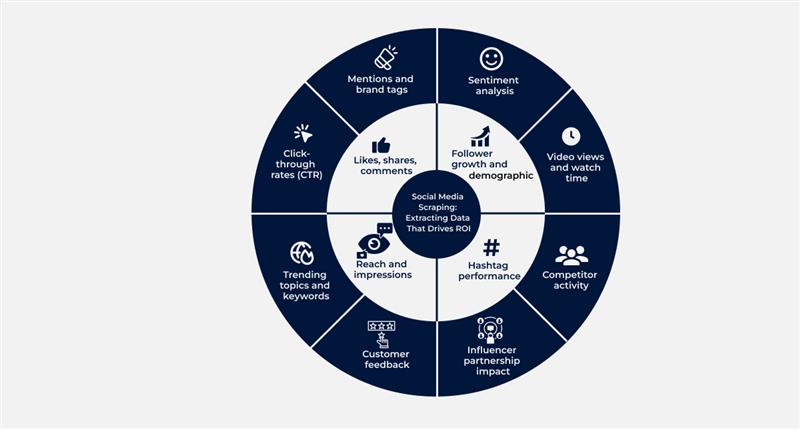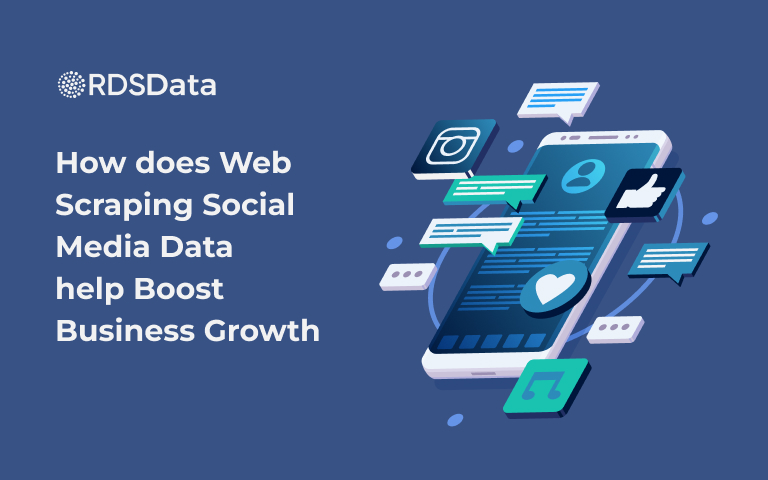Social media is no longer just a platform for communication; it has become a massive repository of structured and unstructured data. Every post, comment, share, or reaction represents consumer behavior, sentiment, and engagement patterns that can be translated into actionable business insights. For enterprises, understanding this information is critical to making data-driven decisions that impact revenue, brand positioning, and market share.
However, collecting this amount of data manually from platforms like Twitter, LinkedIn, Instagram, or Facebook is impossible. Businesses now rely on web scraping and data extraction techniques to transform raw social media content into structured, actionable insights.
According to HubSpot’s State of Marketing Report 2025, over 30% of marketers rely on data to identify their most effective strategies. Nearly 30% report that it directly boosts ROI, while 27% indicate it enhances their ability to reach the right audience efficiently.
This guide explains, in a structured and practical manner, how social media data scraping helps businesses gain a competitive edge, improve marketing strategies, and optimize overall decision-making.
Understand Social Media Data
Types of social media data and their business relevance

Social media data comes in various forms, each providing unique business value:
- Engagement Metrics: Likes, shares, comments, retweets, and reactions indicate user interest and content performance. This data helps businesses optimize campaigns in real time.
- Demographic Data: Age, gender, location, and interests of users inform targeted marketing strategies.
- Sentiment Analysis: Natural language processing on posts and comments helps evaluate consumer sentiment, identify pain points, and improve customer experience.
- Competitor Data: Monitoring competitors’ social media activities allows benchmarking and spotting emerging opportunities.
- Trend Analysis: Identifying hashtags, viral topics, and trending discussions aids in market research and product innovation.
According to Forrester (2024), insights from social media play a significant role in guiding marketing and product decisions for a majority of businesses, shaping strategy and resource allocation.
Why Web Scraping is Crucial for Businesses
1. Real-time insights
Real-time data extraction ensures businesses are not making decisions on outdated information. With social media platforms updating constantly, a lag in understanding audience reactions can lead to missed opportunities. Web scrapers automate data collection from multiple channels simultaneously, ensuring executives have immediate access to trends, sentiment shifts, or potential crises.
2. Large-scale data collection across multiple platforms
Collecting massive volumes of social media data manually is unfeasible. Automated scraping can aggregate millions of data points across platforms, providing a holistic view of consumer behavior. Enterprises dealing with multiple brands or product lines require this scale to make informed decisions.
3. Trend prediction and market intelligence
Using historical social media data, businesses can forecast emerging trends and adjust marketing campaigns proactively. AI models combined with scraped data improve predictive accuracy, allowing companies to align product launches and promotions with market interest.
4. Competitor analysis and benchmarking
Web scraping allows organizations to monitor competitor campaigns, audience engagement, content types, and posting frequency. Insights from structured data provide a competitive edge, helping executives refine their strategies while avoiding trial-and-error approaches.
How Social Media Data Drives Business Growth
1. Optimizing Marketing Strategy
Analyzing engagement metrics, sentiment, and trends allows marketing teams to fine-tune campaigns. Decision-makers can identify which type of content resonates with target audiences and allocate resources.
2. Product Development & Innovation
Feedback from social media reveals product strengths and weaknesses in real time. Consumer behavior analysis enables executives to prioritize feature development, address pain points, and innovate based on actual user demand rather than assumptions.
3. Customer Experience Enhancement
Monitoring customer interactions and sentiment on social media allows companies to anticipate service issues, respond promptly, and improve customer retention rates.
According to the Customer Experience Trends Report 2022, 93% of customers expect a response within 24 hours when reaching out via social media. Companies that meet this expectation experience significantly higher customer satisfaction and retention rates.
4. Competitive Intelligence
Tracking competitor content, engagement, and campaign strategies provides benchmarks for performance. Businesses can identify untapped opportunities or adjust pricing and messaging strategies to maintain market share.
5. Market Trend Analysis
Scraping large datasets enables predictive analytics, helping businesses spot emerging trends before competitors. This is crucial for fast-moving industries like retail, consumer electronics, and FMCG.
According to McKinsey, companies leveraging predictive analytics and data-driven personalization, including social data, can achieve a 10–15% increase in revenue growth, with some cases reporting up to 25%.
Ethical & Legal Considerations
While web scraping provides powerful insights, it must be conducted responsibly. Executives must ensure compliance with platform policies, data privacy regulations, and copyright laws. Using structured data ethically avoids legal risks while maintaining trust with stakeholders.
Choosing the Right Web Scraping Approach for Social Media
1. Accuracy and reliability
Enterprise-level scraping focuses on high-fidelity data extraction to avoid inconsistencies and duplicates. Accurate data ensures that insights are actionable and reliable for decision-making.
2. Scalability for large datasets
Scraping systems should handle millions of social media entries efficiently. Cloud-based solutions or distributed scraping architectures allow scaling without compromising speed or quality.
3. Real-time vs batch processing
Businesses must balance real-time insights with historical trend analysis. Real-time scraping allows immediate decision-making, while batch processing helps identify long-term patterns and market shifts.
4. Integration with analytics tools for decision-making
Scraped data must seamlessly feed into BI tools, CRM systems, and AI-driven platforms to generate actionable insights for marketing, sales, and product teams.
Outsourcing Social Media Data Extraction to Experts
For large-scale social media data intelligence needs, collaborating with experienced enterprise-grade web scraping specialists ensures accuracy, compliance, and scalability.
We at RDS Data act as your social media data acquisition partner, which means you can focus on interpreting insights and making strategic decisions, while leaving the complexities of data extraction, cleaning, and processing to us.
This approach ensures that your business leverages social media data effectively, gaining a competitive edge without the overhead of manual data collection.
Key Takeaways
- Social media data is a goldmine for business insights.
- Web scraping transforms raw posts, comments, and engagement metrics into structured data.
- Businesses using social media data strategically gain a competitive edge, improve marketing ROI, and enhance customer experience.
- Ethical and compliant scraping ensures long-term sustainability.
- Leveraging predictive analytics on social media datasets supports informed, strategic decisions.
FAQs
Tired of broken scrapers and messy data?
Let us handle the complexity while you focus on insights.

